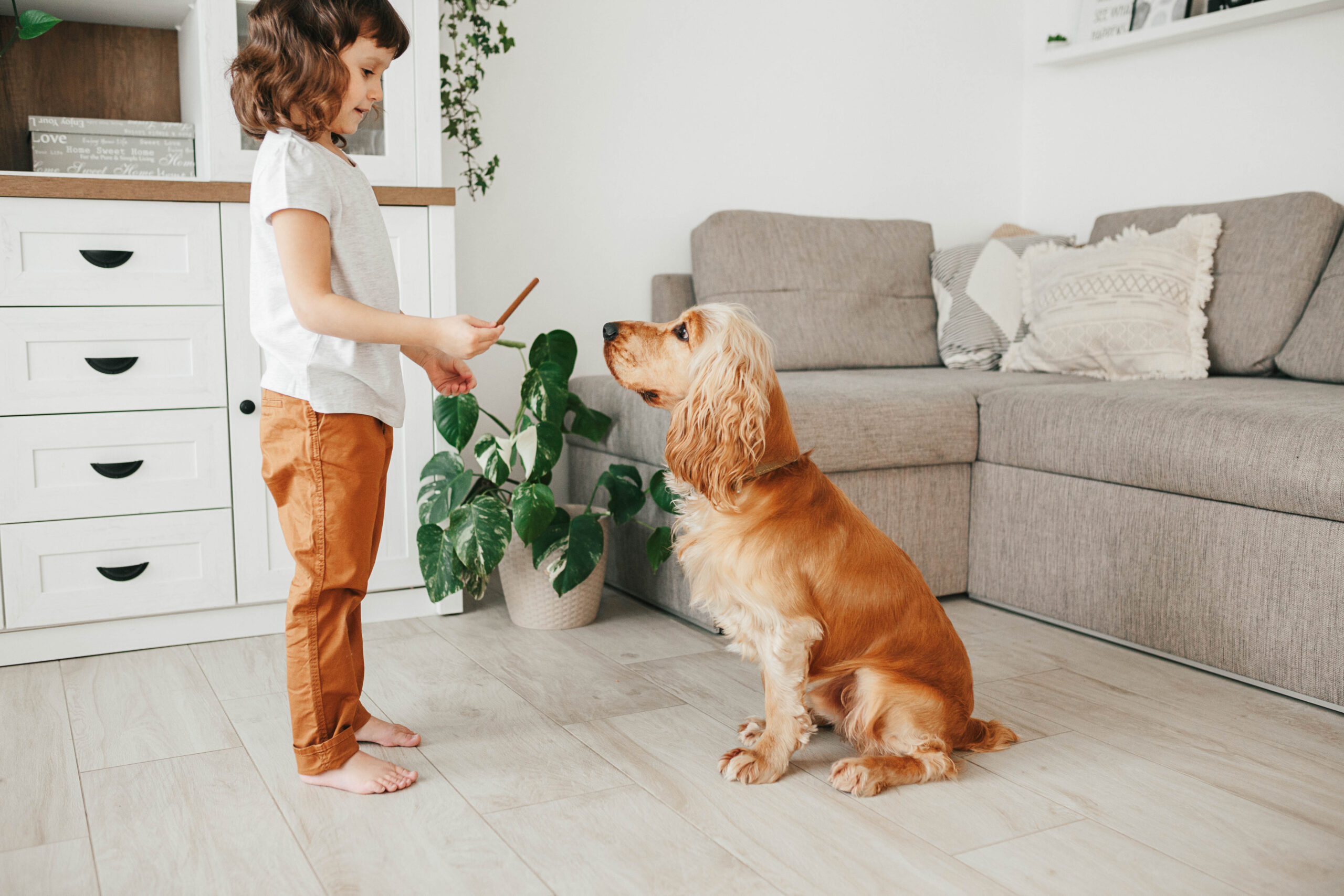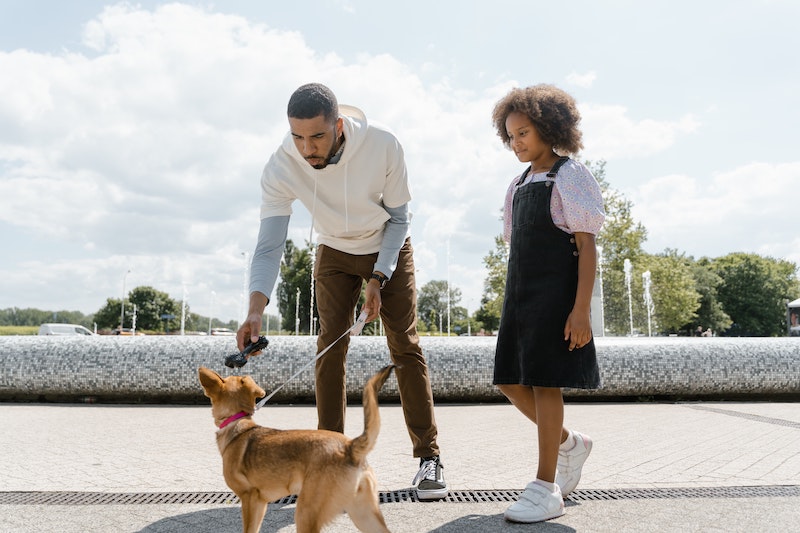Kids Can Make Great Dog Trainers
Here's how your littles can help when a pup joins the family.

Here's how your littles can help when a pup joins the family.

Terry Dixon was three when she first started asking her parents for a dog. Whether it was her birthday, Christmas, or practically any day of the week—she wanted a dog.
“She loves animals,” her mom, Katherine Dixon, says. “She played with the two dogs at her grandma’s house, and when one of her friends got a new puppy that is all she talked about.”
Before her fifth birthday, her parents sat her down to discuss caring for and training a new dog. “We thought it would be best to visit a local animal shelter,” Katherine recalls. “I told the shelter we wanted a small- to medium-size puppy or young dog that we could train. Breed didn’t matter. Good behavior did. We had three dogs in mind. On Terry’s birthday, we took her to the shelter to see one of them, and she fell in love immediately.”
Now the fun could really begin.
The Dixon family “assigned” 5-year-old Terry crate-training and dog-walking. When they picked up Breezy, a German Shepherd/Collie mix, they placed her in a crate. “She got used to it immediately,” Katherine says. “We would place Breezy in it whenever we were out of the house.”
Terry placed dog treats, a chew toy, and a soft blanket inside the crate. They also put one of Terry’s soft sweatshirts in the crate so Breezy, who was about 10 months old, would familiarize herself with Terry’s scent.
Terry would walk Breezy in the morning before school, and in the afternoon when she returned home from school. Her mom took the night shifts. “We are so proud of Terry because she doesn’t complain about the schedule, and she picks up after Breezy,” her mom says. “On their walks together, she taught Breezy not to pull.”
With a little effort, this experience can be beneficial for everyone involved—and can be a great way for a young person to feel a sense of achievement and mastery.
“It’s important to get children involved with training the family dog,” Marissa Sunny, supervisor of Lifesaving and Care at Best Friends West Los Angeles. “It provides a consistent experience for the dog. So, ideally, the dog is getting the same cues with the same rewards from everyone they are interacting with. For the kids training the dog, it also lets them see the benefit of the work they are doing for both themselves and the dog.”
And perhaps, most importantly, “it creates a deeper bond between the child and the dog.”
One rule for parents to keep in mind: Never leave a small child and a new dog or new puppy alone. It’s important to make sure your child and the family dog are safe. Infants tend to grab—everything, a lot—and toddlers might be tempted to roughhouse with the new puppy. Even a well-behaved dog can bite if provoked.
Have a family meeting to make sure you are all in agreement as to how you’re training a new dog, and what behaviors you’re looking to encourage or avoid. If dad is teaching the family dog not to jump, while the 9-year-old is rewarding the pooch for leaping into the air, your pet will be confused.
Mixed signals are confusing for young kids and young pups alike.
Some dog trainers use a clicker, which you can purchase at a pet shop or online at a pet supply store. Clickers often replace treats. Each time your child gives a command and the dog performs the new skill, have your child click the clicker. It helps to praise your dog’s good behavior at the exact moment when they demonstrate a skill, helping to solidify those skills faster.
Children using a clicker should be mature enough not to haphazardly click it. In general, kids seven and up can use the tool responsibility. If your child is overzealous, use treats instead—but be sure to supervise, since treats are highly caloric.
Rewarding your dog with a treat reinforces good behavior. It’s just important not to overdo it. More than 50 percent of household dogs are obese, and obesity leads to health problems. Teach your kids (and your pup) that praise comes in many different forms.
If you decide to let your child train the dog with treats, limit the number of treats you give to your child and tell them to make them last, and that they should only be given out when the dog perfectly performs the task. Children as young as age five can usually take part in this process.
Pro-tip: Some trainers break treats into two or three pieces, depending on the size. They give the dog one of these small pieces each time a new task is accomplished. Breaking apart the treats with your kids can be yet another activity connected to the ongoing training of your pet.

One way of teaching children proper training techniques is to enroll your family in a dog-training program, if your budget permits it. Classes are available at some chain pet stores and through private trainers.
A good dog trainer can teach you to read your dog’s body language, how to use positive reinforcement, and simple tricks such as how to sit, lie down, play fun games like retrieving a frisbee, and other good dog behaviors.
Depending on the age of your child, a trainer can keep the goals simple. Small children can teach children to have their dogs sit, stay, and shake their paws. Making this a family affair allows everyone in the household to be on the same page when it comes to a training regimen.
If you have more than one child in your family, have them share the training duties. Split the chores according to age. An older child, around age 13 and up, can take the family dog on long walks and to the dog park for socialization. That said, it’s best to initially accompany your child and dog to the dog park so you can see which dogs are friendly and which ones should be avoided.
Older children can also teach potty training by taking the family dog outside a few times a day to do their business. Younger kids can be assigned simpler tasks, like pouring food or water into a bowl under supervision; the stakes are low, but they’ll still feel a sense of pride.
Everyone should help teach the family dog their name. It’s a simple trick that’s achieved with a lot of repetition. Everyone in the house should use the dog’s name when addressing or calling them.
Children as young as four or five can teach the dog to sit. Use that simplest of commands—“sit”—and place your child’s hand on the dog’s back to gently press down from a standing position. Most likely, you’ll have to repeat this a few times. When the dog successfully sits, have your child hit the clicker or give the dog a small treat.
Children ages five and up can teach the dog to stay, come, and shake their paw. Children ages six and up can train dogs to find objects. To do this, have your child hide a treat and ask your dog to find it. Your dog’s sense of smell is more sensitive than ours. Start by hiding the treat in plain sight. Praise your dog when he finds it; then start hiding it further away.

If your child is old enough to walk the family dog on his own, show them how to teach the dog to heel. Children five and younger may run with the dog and let the dog pull them. So, you’ll want your child to be mature enough to know “no pulling.”
To accomplish this, have your child hold the leash close to his side, and say “heel.” Have your child walk slowly, and each time your dog stays close to your side continuing saying “heel” and “good dog.”
In general, though, don’t overwhelm the family dog with too many tricks and commands. Too much information can confuse a child, an adult, and a dog. Repetition is essential and once your dog achieves the task, move on to the next one. Just limit it to one or two new tricks every few days. Be sure to review the tasks your dog (and your kids!) have accomplished. Practice, as always, makes perfect.
Each time your child successfully teaches the family dog a new task and the dog performs it well, be sure to praise your child for being a great dog trainer. While your pup will be mastering new tricks and good behaviors, your son or daughter will be learning a valuable sense of mastery and achievement.
With all of that praise and growth happening in your household, your kids—whether of the two- or four-legged variety—will be better prepared for whatever life throws at them.
Speaking of the unexpected: If you’re about to welcome a new pup in your family, you might want to get them hooked up with pet insurance, like coverage offered by Lemonade.
A base accident and illness policy will help cover unexpected vet bills in case of an emergency, plus, if you adopt a pup younger than two-years-old you can enjoy Lemonade’s preventative package for puppies and kittens, which can help pay for vaccines, wellness exams, tests, spaying/neutering, microchipping, and more.
Apply today to see if Lemonade is right for your fur fam—click the button below to get started.
A few quick words, because we <3 our lawyers: This post is general in nature, and any statement in it doesn’t alter the terms, conditions, exclusions, or limitations of policies issued by Lemonade, which differ according to your state of residence. You’re encouraged to discuss your specific circumstances with your own professional advisors. The purpose of this post is merely to provide you with info and insights you can use to make such discussions more productive! Naturally, all comments by, or references to, third parties represent their own views, and Lemonade assumes no responsibility for them. Coverage and discounts may not be available in all states.
Please note: Lemonade articles and other editorial content are meant for educational purposes only, and should not be relied upon instead of professional legal, insurance or financial advice. The content of these educational articles does not alter the terms, conditions, exclusions, or limitations of policies issued by Lemonade, which differ according to your state of residence. While we regularly review previously published content to ensure it is accurate and up-to-date, there may be instances in which legal conditions or policy details have changed since publication. Any hypothetical examples used in Lemonade editorial content are purely expositional. Hypothetical examples do not alter or bind Lemonade to any application of your insurance policy to the particular facts and circumstances of any actual claim.